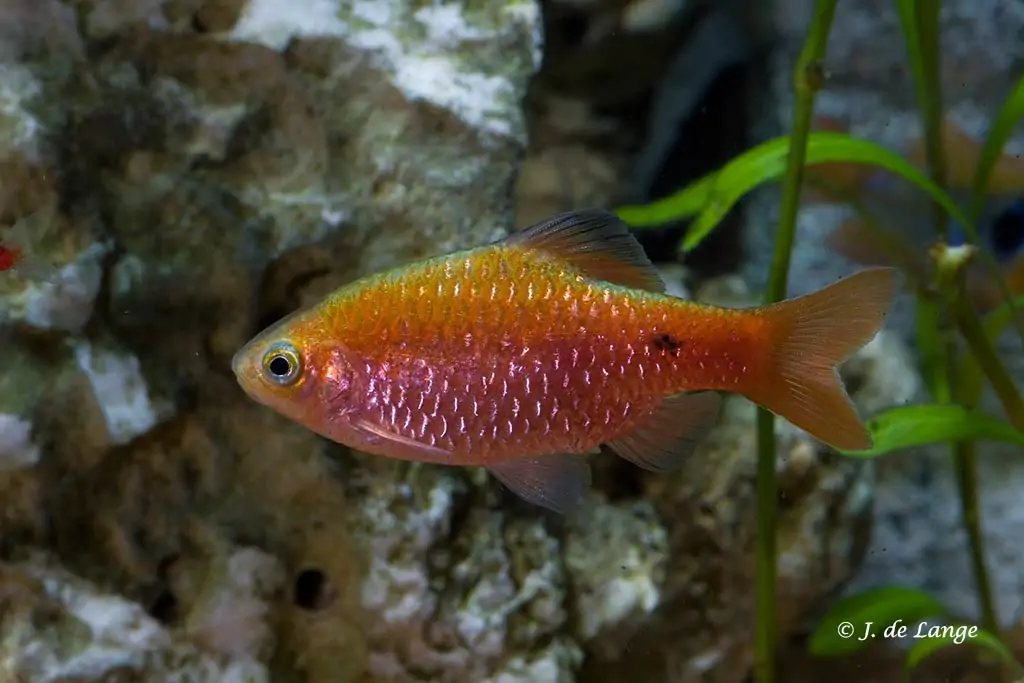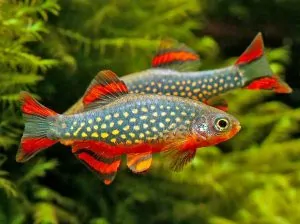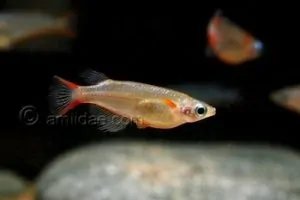Pethia conchonius – Rosy Barb
Pethia conchonius or Rosy Barb is a colorful active species that can grow considerably larger in the wild than in the aquarium. In the aquarium they usually do not grow larger than 5 to 6 centimeters while in the wild they can reach a length of up to 12 centimeters. Although they leave other fish alone, it is not advisable to combine this species with overly calm or delicate fish due to its very active swimming behavior. Do not keep them with Angelfish or Gouramis, as they will nip on their fins, they will leave other lively species alone.
The difference between males and females is clearly visible: the male is much redder and leaner. The female is a bit plumper. The Rosy Barb is a real schooling fish. Put 6 or more specimens together and they keep swimming close together.
The Aquarium
How the aquarium is decorated does not really matter, as long as there is enough swimming space. The tank can be decorated with a dense edge plantation such as Vallisneria, Cambomba or Java Moss. They like a lot of current but this is not necessary. When searching for food, they occasionally gobble over the soil. Sharp gravel is therefore not recommended. They can also be kept outside in the summer in large tank or a pond. Ensure that they can go back in when the temperature drops.
Diet
The Rosy Barb is also not a difficult fish when it comes to food. All types of food are gladly included. Dry food, fine soft plant leaves but also live (frozen) food such as mosquito larvae, daphia, and brine shrimps can be given. Make sure there is enough variety.
Origin
Pethia conchonius has a large distribution area. The intensity of the colors may vary somewhat depending on the origin. They occur in the north of India, Banglades, Pakistan and Nepal. The specimens from the Siwalik mountains in northern India seem to be the most beautifully colored with highly reflective scales.
You will not find any wild-catch specimens in the trade. They are re-grown for the aquarium and selected for color. You will probably not encounter the very colorful variant that we keep in the aquarium in the wild.
Breeding
Breeding Pethia conchonius is relatively easy. You do need a separate breeding tank for this, since they are notorious egg eaters. The breeding tank preferably has a place where it catches the morning sun. Place 2 layers of marbles on the bottom to prevent the parents from eating the eggs immediately. Above the marbles a large bunch of Java Moss or Myriophyllum between which the parents will lay the eggs. The breeding tank must be equipped with cover panes. When mating, they sometimes pop out of the water.
If you regularly look at the Rosy Barb school, it is obvious which 2 form a pair, they always seek each other out. You place this male and female in the breeding tank in the evening. They often lay eggs the next morning. After depositing the 200-300 eggs you can remove the parents. The fry hatch after 30 hours and can be fed with fine dried food and fresh hatched brine shrimps.
Etymology
The name Pethia is a local collective name for various small Cyprinids. Conchonius means something like delicate beard.
Synonyms: Cyprinus conchonius, Barbus conchonius, Puntius conchonius, Systomus conchonius, Barbus conchonlus, Systomus pyropterus, Barbus pyrhopterus, Systomus pyrrhopterus, Puntius conchonius khagariansis.
Video
Authors
Coby – John de Lange
Copyright images
John de Lange
Hristo Hristov















Reviews
There are no reviews yet.